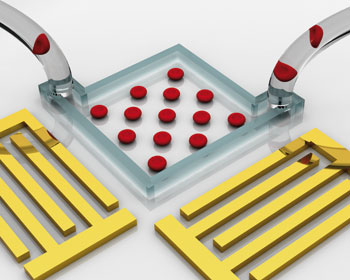УРАЛЬСКОЕ ОТДЕЛЕНИЕ
РОССИЙСКАЯ АКАДЕМИЯ НАУК УРАЛЬСКОЕ ОТДЕЛЕНИЕ ИНСТИТУТ ХИМИИ TBEPДОГО ТЕЛА |
|
|
| 17.08.2009 |
|
|
|
 Tony Jun Huang and colleagues at the Pennsylvania State University, University Park, made the tweezers by placing two energy conversion devices called interdigital transducers (IDTs) on the outside of a microfluidic channel. They added a microparticle solution to the channel and then applied a radio frequency signal to the IDTs. The IDTs converted the signal into sound waves called surface acoustic waves (SAWs), which pushed the microparticles into precise patterns in the channel. SAWs are very energy efficient, Huang explains - acoustic tweezers use 500000 times less power than optical tweezers, an existing patterning method. This makes them cheaper and also prevents damage to biological samples. "This is a very interesting way of using acoustic waves" - Michael Thompson, University of Toronto, Canada The tweezers work on a variety of different cells and particles regardless of size, shape or charge, adds Huang. The team used them to pattern polystyrene beads, Escherichia coli and red blood cells. 'This is a very interesting way of using acoustic waves, as SAWs have not been used for this sort of application before,' states Michael Thompson, an acoustic wave expert at the University of Toronto, Canada. Huang says future research will be focused in two directions. 'Firstly, we are going smaller by manipulating nano-objects, such as DNA, viruses and nanowires,' he comments. 'Secondly, we want to use our acoustic tweezers in biomedicine. We have already talked to cell biologists and they are very interested in this technology.' Jane Hordern
Enjoy this story? Spread the word using the 'tools' menu on the left or add a comment to the Chemistry World blog. Link to journal articleAcoustic tweezers: patterning cells and microparticles using standing surface acoustic waves (SSAW)
|
|
|
|||||||||||||||||||||||||||||||||||||||||||||||||||||||||||||||||
|
|
|
|
|||||||





|